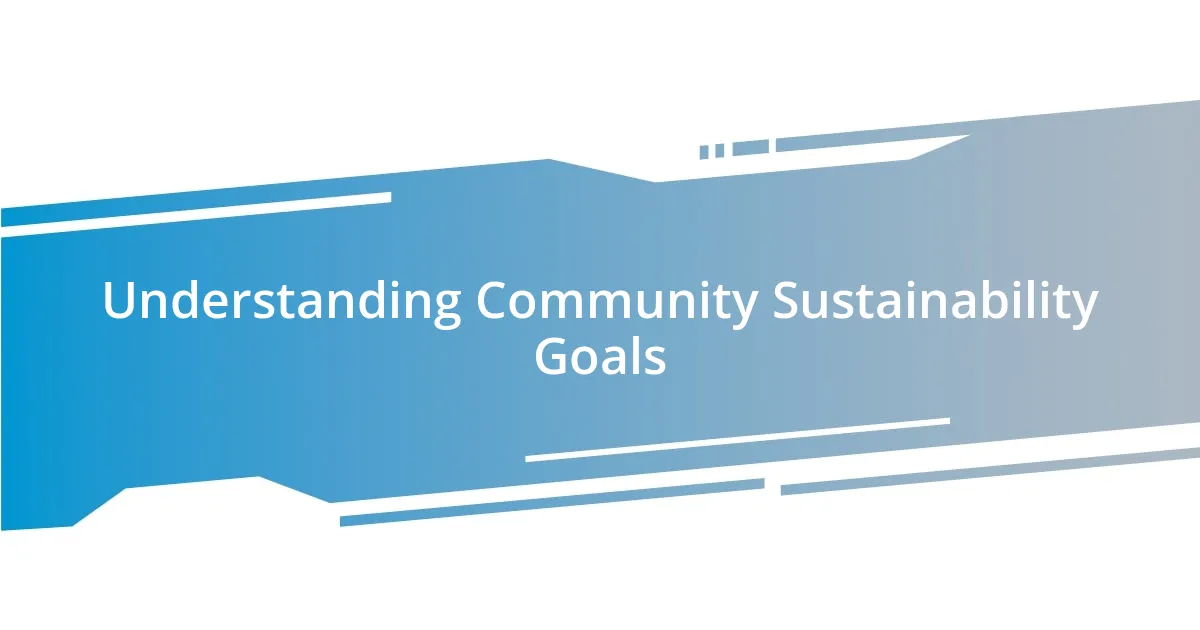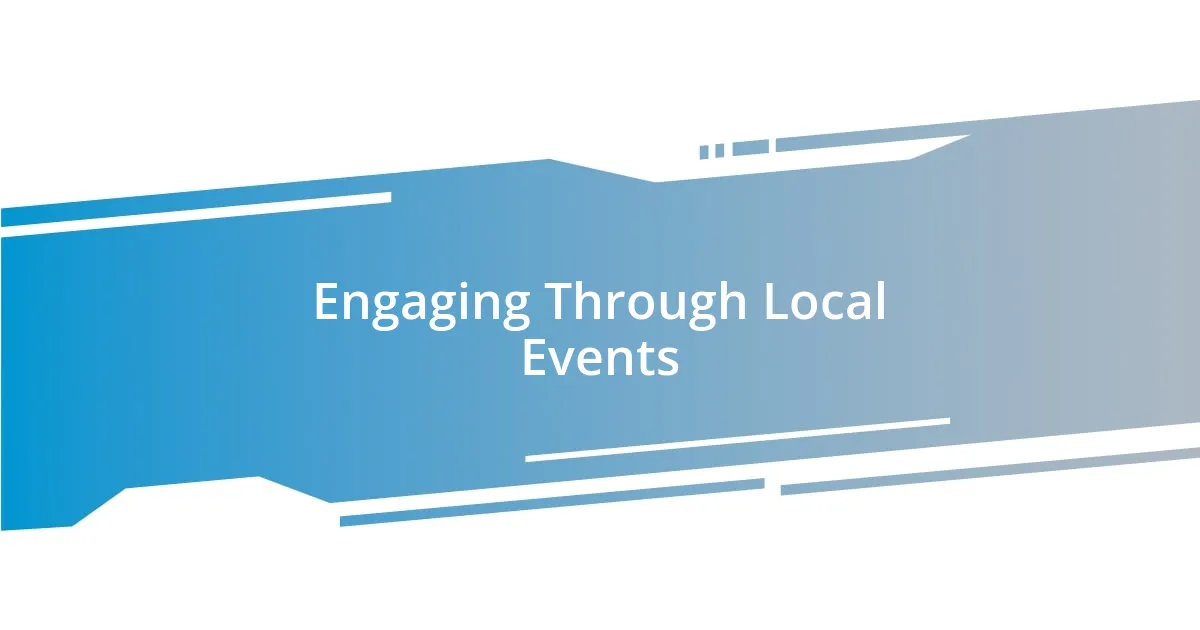Key takeaways:
- Engaging the community through local events fosters connections and inspires commitment to sustainability.
- Identifying and involving diverse stakeholders enhances project support and sparks innovative ideas.
- Utilizing social media effectively amplifies community voices and promotes real-time engagement in sustainability efforts.
- Celebrating successes and recognizing individual contributions help maintain momentum and inspire ongoing participation in sustainability initiatives.

Understanding Community Sustainability Goals
Community sustainability goals are often the backbone of any successful initiative aimed at fostering a healthier environment. I recall a community meeting I attended where locals expressed a shared desire to reduce waste and enhance green spaces. It was truly moving to see how passionate everyone was about creating a vibrant, sustainable area for future generations—have you ever felt that collective energy in a room?
Understanding these goals involves recognizing the unique needs and values of your community. For instance, when we assessed our recycling program, it became clear that some residents weren’t participating because they felt confused about what materials were recyclable. This revelation prompted us to develop clearer guidelines and host workshops—simple steps that made a significant difference.
Moreover, engaging with diverse voices within the community can reveal different sustainability perspectives. I remember hosting a discussion with local farmers who highlighted the importance of sustainable agriculture. Their insights inspired us to integrate practices that not only benefit the environment but also support local economies—how do you think diverse viewpoints can shape your community’s sustainability efforts?

Identifying Key Community Stakeholders
Identifying key community stakeholders can truly transform your sustainability initiatives. I vividly recall a workshop where we brainstormed all the different people and organizations that could play a part in our efforts. From local business owners to school representatives and environmental groups, each voice brought a unique perspective. This diversity not only helps to broaden support but can also spark innovative ideas—what unexpected stakeholder have you engaged with in your efforts?
To make this process more manageable, I found it helpful to categorize stakeholders based on their influence and interest. Here’s a list of potential key players to consider:
- Local Government Officials: They can provide necessary support and resources.
- Community Leaders: Those with established trust can encourage others to participate.
- Environmental Organizations: Their expertise can guide sustainable practices.
- Schools and Educational Institutions: They can serve as platforms for outreach and education.
- Businesses: Engaging them can lead to sponsorships and resources, while demonstrating corporate responsibility.
Strategically involving these stakeholders fosters a sense of ownership and can lead to a more engaged community. When individuals feel invested, they are more likely to contribute passion and energy to sustainability initiatives.

Creating Collaborative Sustainability Projects
Creating collaborative sustainability projects is an exciting venture that brings people together for a common goal. I remember when we initiated our community garden; it was a simple idea that blossomed into a hub of activity. Neighbors came together, sharing seeds, tips, and laughter as we learned from each other’s experiences. It was heartwarming to see the garden thrive, both in plants and the community spirit.
Collaboration often requires creativity in project design. I’ve found that hosting design thinking workshops can spark inspiration among participants. During one such workshop, a surprising outcome was a solar-powered art installation that not only highlighted the importance of renewable energy but also became a local landmark. It made me realize how collective brainstorming can transform an ordinary project into something extraordinary. Have you ever tried facilitating a creative session to gather ideas? It can be liberating.
Moreover, establishing clear roles within the project can manage expectations and enhance accountability. In my experience, assigning specific tasks based on individual strengths helped strengthen our community bonds. I recall how one resident with a background in graphic design volunteered to create promotional materials for our recycling initiative. This not only lightened the workload but also fostered a sense of pride and ownership as each person’s contributions were recognized. When everyone feels a part of the journey, the project’s impact often widens.
| Collaboration Type | Benefits |
|---|---|
| Community Workshops | Encourages idea sharing and engagement |
| Task Assignment | Fosters accountability and utilizes individual strengths |
| Public Events | Increases visibility and community participation |

Engaging Through Local Events
Engaging the community through local events is one of the most effective strategies I’ve discovered. I once organized a sustainability fair in our town square, inviting local artisans, eco-friendly vendors, and even a beloved local band to perform. The energy was contagious, and it didn’t just draw attendees; it ignited conversations about sustainability. Have you ever felt the buzz of a shared experience like that? It’s remarkable how such events can foster connections and inspire commitment.
One particularly memorable moment unfolded during a panel discussion led by community members who had successfully implemented green practices in their homes and businesses. Seeing residents bravely share their stories not only affirmed the feasibility of sustainability but also inspired others to take action. I still remember the excitement on people’s faces as they encouraged one another to adopt new habits. Engaging through personal narratives can have a profound impact—what tales resonate with your community’s journey?
Furthermore, I’ve learned that having engaging activities for all ages creates an inviting atmosphere. At the fair, we set up interactive workshops where kids made bird feeders from recycled materials. Watching them playfully learn about conservation while crafting reminded me why I got involved in the first place. It’s a joy to witness the next generation embracing sustainability. How can you incorporate fun, hands-on experiences into your local events? Every little effort counts in weaving together a more sustainable future.

Utilizing Social Media for Outreach
Utilizing social media for outreach has become a game changer in engaging the community. I recall the day I posted a poll on our community Facebook group, asking for ideas on our next sustainability project. The overwhelming response was eye-opening; people were excited to contribute and share their thoughts. Have you ever been surprised by how eager your neighbors are to jump into the conversation? Social media can truly amplify voices that might otherwise go unheard.
Through platforms like Instagram, I was able to showcase our progress in real-time. I remember capturing a time-lapse video of our community garden coming to life, from planting seeds to blooming flowers. When I shared that video, the comments poured in—neighbors tagging one another, reminiscing about their childhood gardens. It was a wonderful reminder of how visuals can invoke nostalgia and foster a sense of unity. How often do you think about the stories that simple images can tell?
Additionally, I found that hosting virtual Q&A sessions allowed us to foster deeper connections. During one such session, a local expert joined us to discuss sustainable practices. I was amazed by the level of engagement; participants submitted questions in advance, and the discussion naturally flowed. This interaction highlighted the power of social media to create a dialogue, bridging the gap between information and action. Have you explored how digital engagement can transform awareness into enthusiasm? It’s a path worth taking for any community dedicated to sustainability.

Measuring Community Involvement Impact
Measuring the impact of community involvement in sustainability can sometimes feel like navigating uncharted waters. I remember when I introduced feedback surveys after our community clean-up day. The results were enlightening, revealing not just participation numbers, but also shifts in awareness and attitudes toward local environmental issues. It’s fascinating how a simple survey can provide both quantitative data and heartfelt stories from participants about how the event inspired them to make sustainable choices at home.
One approach that proved invaluable was tracking changes in behavior over time. Following our initial clean-up, I initiated follow-up interviews with volunteers. As we sat down with a cup of coffee, hearing their personal transformations—like one neighbor giving up single-use plastics—filled me with pride. Have you considered how understanding individual journeys can enrich the overall picture? When you can link community action to personal change, it creates a tapestry of impact that’s truly inspiring.
Moreover, I learned the significance of celebrating milestones together. After we had the community garden thriving for a year, we held a harvest festival. As we shared the bounty, members reflected on what this collective effort meant to them. One person shared how growing their own food reignited family traditions and bonding moments. Isn’t it eye-opening how these shared experiences can deepen the community’s commitment to sustainability? Measuring impact is not only about numbers; it’s about weaving together stories that resonate and empower us all.

Celebrating Success and Keeping Momentum
Celebrating success is where the magic truly happens. I recall our community’s first Earth Day festival, where we showcased our sustainability initiatives. The excitement in the air was contagious as families came together, sharing their experiences and successes. Have you ever felt that surge of pride when you realize your efforts have inspired others? It’s moments like these that spark the motivation to keep going.
To maintain momentum, I learned that continuous recognition is key. We made a habit of spotlighting individuals who went above and beyond in their sustainability efforts. Remembering the day we honored a local youth for organizing a plastic-free initiative was incredibly special. The smiles on their faces as they received their awards were priceless. It really hits home when you see how acknowledgment can fuel further action. How often do we stop to celebrate the small victories that lead to larger changes?
Another strategy I embraced was regular community gatherings to reflect and plan ahead. During one of these informal sessions, a neighbor proposed a collaborative project on rainwater harvesting. The ideas flowed freely, and I could see the enthusiasm in everyone’s eyes. Isn’t it inspiring how simply coming together to celebrate past successes can ignite new passions? Keeping the dialogue alive not only solidifies our achievements; it propels us toward even greater goals in our sustainability journey.












